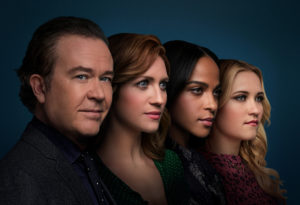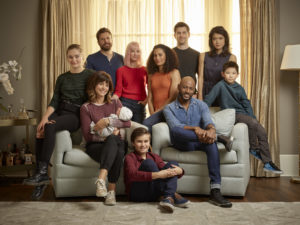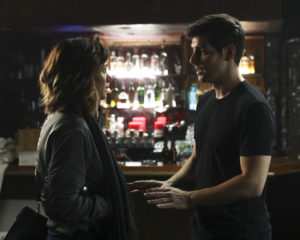Adoptees, NPEs, and donor conceived people drive plots in TV dramas, but do these shows get it right? Warning: spoiler alerts ahead.
As the new network television season begins this week, adoptees, NPEs (not parent expected or non-parental events), and donor conceived individuals are among the casts of characters on primetime programs. But will the series’ writers and producers bring a level of reality and depth to the depictions or simply exploit their experiences for dramatic purposes without accuracy, nuance, and sensitivity?
Donor Conception in "Almost Family"

ALMOST FAMILY: L-R: Megalyn Echikunwoke as Edie Palmer, Brittany Snow as Julia Bechley and Emily Osment as Roxy Doyle in Season 1 of ALMOST FAMILY premiering Wednesday, October 2 (9:00-10:00pm PM ET/PT) on FOX. ©2019 Fox Media LLC. CR: Elisabeth Caren/FOX.
On October 2, the first show with a high-concept premise about donor conception premieres on Fox. The plot of “Almost Family” unfolds as it becomes known that renowned fertility doctor Leon Bechley boosted his clinic’s success rate by using his own sperm to help clients conceive—a practice that led to the conception of dozens of children.
While it would appear to be a plot line ripped from recent headlines, the show is based on the Australian Network 10 series “Sisters,” which premiered in October 2017 and may have been inspired by an earlier headline concerning an Indiana fertility doctor who in 2016 was sued for using his own sperm more than 50 times to inseminate patients. The show began streaming as a Netflix Original Series in September 2018.
As in “Sisters,” “Almost Family” focuses on the effect this bombshell has on Bechley’s daughter, Julia, and two women who discover that they were conceived from his sperm. One, Edie Palmer, has been a longtime friend of Julia. The other is a former Olympic athlete, Roxy Doyle.
Both shows purport to be about the redefinition of family and the issues that surface as these sisters face the facts of their conception, navigate the challenges, and encounter an ever-increasing number of siblings.

ALMOST FAMILY: L-R: Timothy Hutton as Dr. Leon Bechley, Brittany Snow as Julia Bechley, Megalyn Echikunwoke as Edie Palmer and Emily Osment as Roxy Doyle in Season 1 of ALMOST FAMILY premiering Wednesday, October 2 (9:00-10:00pm PM ET/PT) on FOX. ©2019 Fox Media LLC. CR: Elisabeth Caren/FOX.
“Sisters,” with 7 episodes, begins promisingly enough. Dialogue suggests that feelings, experiences, and concerns arising from the characters’ discovery that they not only were donor conceived but conceived with the sperm of a fertility doctor will be on point. One of the sisters, for example, wonders if this secret has been the root cause of her lifetime of distress—if it explains why she’s never felt right, why she doesn’t resemble her father. Another sister tangles with a narcissistic mother who tells her she “didn’t miss out on anything” and insists that her life hasn’t changed as a result of this new knowledge. When her daughter tries to make her understand that it has everything to do with who she “is as a person,” the mother dismisses her feelings. Learning of the fertility clinic debacle, Julia Bechley feels as if it’s “just me in a car driving into a tidal wave of shit.” Another feels “shaking, spitting, fury.” One, looking on the brighter side, says, “we’re going to be the people we never knew we were supposed to be.”
If any of that resonates for donor conceived individuals and forecasts a sober exploration of the reality of the situation, what follows may be disappointing. “Sisters” takes a downturn after the first episode, steers away from reality, and devolves into silliness; the drama begins to seem more like an extended sit-com, with the premise as little more than a device for preposterous scenarios in which characters behave unrealistically as they become involved in complications that have little if anything to do with the ramifications of donor conception.
Will “Almost Family” handle the premise more seriously? At the Television Critics Association summer press tour, reporters, according to “TV Guide,” posed hard questions to the new show’s executive producer Jason Katims and writer Annie Weisman. One reporter questioned both an entertainment premise based on “insemination fraud” and the show’s depiction of Bechley as a sympathetic character. Katim asserted that the show focuses on the daughters more than on Bechley’s transgression and on how they connect after the public revelation of his wrongdoing.
Weisman assured reporters that the ramifications of Bechley’s actions and his breach of trust would be taken very seriously. The show, she insisted, will explore questions of identity and what makes a family while exploring the moral and ethical implications. At the same time, Weisman noted that more siblings will emerge over the course of the season, which she describes as “part of the fun of the premise.” Donor conceived individuals understandably might not only take issue with the premise being described as fun, but likely also will bristle at Weisman’s characterization of fertility doctors who broke the rules as outlaws with a visionary sense. It remains to be seen whether “Almost Family” will present a realistic depiction of donor conceived individuals, but the creators’ language doesn’t bode well for a nuanced presentation.
Adoption and Foster Care in “Grey’s Anatomy” and “This is Us”
Adoption is far from a new topic in network television, but what seems fresh is a departure from the stories in which adoption is the perfect, unblemished solution to babies in need and parents who desire them.
“This is Us”—a wildly popular tearjerker drama—follows Rebecca and Jack Pearson and their three children through flashbacks and flashforwards. It begins in the 1980s as Rebecca and Jack have conceived triplets. Rebecca delivers two healthy babies but the third doesn’t survive. By coincidence, another baby born the same day and whose mother died of an overdose has been abandoned at a firehouse by a drug-addicted father. The Pearsons adopt the child after overcoming obstacles in the legal system; a black judge refused to sanction the adoption of a black baby by white parents because the child would grow up deprived of his racial identity—this taking place decades before transracial adoption had become relatively commonplace and the adoptees’ unique needs were more widely recognized.
The child, Randall, grows up to be a big-hearted, anxious, highly emotional over-achiever. He’s torn between his love for Jack and Rebecca and his longing to know about his biological parents. In his thirties, he discovers his biological father, who’s nearing the end of his life, and learns that Rebecca knew who he was from the start yet kept that knowledge to herself. Plot lines are devoted to Randall’s fury over this betrayal and his ultimate joy in getting to know his biological father—joy tinged with anger about all the years they weren’t able to be together and the sorrow of knowing their time will be short. Oddly, Randall’s biological mother, so far, has been essentially absent from the drama’s flashbacks.
In later episodes, Randall and his wife, Beth, foster and hope to adopt a troubled black adolescent, Deja. Randall, thinking his experience will allow Deja to relate to him and holding firm to a belief that his love will conquer all, comes to learn that good intentions aren’t enough. Deja, seething and self-protective, educates and challenges him at every turn. The story lines highlight conflicted emotions—those of the characters and the audience—about whether the girl best belongs with Beth and Randall or her own mother who loves her.
“This is Us,” the new season of which premieres September 24, has inspired devotion among legions of viewers who believe the adoptee experience portrayed aligns with their own and has scored criticism from a smaller number who find the depiction too simplistic or unrealistic.
Across more than a decade, “Grey’s Anatomy” has highlighted issues related to adoption with a view that’s far from rose-colored. Throughout the seasons of the show—the 16th of which premieres September 26—conflicts related to adoption are featured frequently. Early on, lead characters Derek Shepherd and Meredith Grey adopt Zola, a six-month old orphan whom Derek had treated at a clinic in Malawi, a process complicated by upheavals in their relationship.
In season 10, a brilliant new cardiovascular surgeon, Maggie Pierce, comes to work at Seattle Grace Hospital. She’s learned that her birthmother, Ellis Grey, a world-famous surgeon, had worked there years ago. What she doesn’t know is that Ellis’ daughter, Meredith, is her half-sister, or that the chief of surgery, Richard Webber, is her father. Webber figures it out first and, to keep the affair he’d had with Ellis from becoming common knowledge, he fails to inform Maggie. As the truth emerges, Maggie’s reunion with her biological family is anything but idyllic. It’s fraught at every turn with issues of trust and betrayal. As Maggie becomes a more prominent character in the drama, her loneliness and lifelong struggles to fit in, her awareness of having missing pieces, and her difficulty with relationships become apparent.
Jo Wilson, another surgeon at the hospital (now called Grey-Sloan Memorial) had been abandoned by her mother shortly after her birth. Story lines make evident that everything in Jo’s experience has been difficult—that her life’s beginning has created heartaches and challenges few can understand. She’s thought about her mother every day of her life and wondered about her own genetic identity. She wrestles with shame and fear of abandonment, which cause her to leave others before they leave her and fuels feelings of inadequacy and otherness. Despite a traumatic upbringing in foster care and an adolescence on the streets, she managed to become a doctor and to flee an abusive husband, creating a new identity for herself. In the most recent season of the show, Jo, having no medical history, is afraid to have children for fear of passing on genetic illnesses. To learn more about her health risks, she takes a DNA test and subsequently discovers the identity of her birthmother. She tracks her down and is devasted to discover that she’s not welcome in her life and, worse, is deeply traumatized by the reason for her mother’s rejection—that she was conceived as a consequence of rape.

GREY’S ANATOMY – on The ABC Television Network. (ABC/Eric McCandless)
CAMILLA LUDDINGTON
These programs may not deal with the full complexity of adoption and foster care and may leave viewers with much to praise and much to criticize, but the characters register emotions that seldom have been expressed in previous screen portrayals. There’s grief, anguish, fear, heartache, conflict, guilt, shame, anger, and rage. There’s acceptance and rejection and happy reunions and bitter disavowals. There are identity crises and traumas associated with the loss of biological family and genetic identity. And in each situation, adoption and foster care aren’t events characters get beyond. They’re shown, instead, to have deleterious effects that persist throughout life.
NPEs in A Million Little Things
While adoption has been a through line in many television shows, NPEs probably haven’t had a significant presence on a network hit since “Peyton Place” in the 1960s. Until now. With a “Big Chill” vibe, ABC’s drama “A Million Little Things,” is about the friendships among a circle of individuals linked by their relationship to Jon Dixon, the group’s linchpin who died by suicide in the first episode. While the series hasn’t yet focused long and hard on issues of genetic identity, it appears to be poised to do so in the second season. The first season episodes set the stage for the potential development of a non-parental event, depicting the way an NPE situation can arise and how the secrets and lies begin.

A MILLION LITTLE THINGS – ABC’s “A Million Little Things” stars Lizzy Greene as Sophie Dixon, Stephanie Szostak as Delilah Dixon, James Roday as Gary Mendez, Allison Miller as Maggie Bloom, Chance Hurstfield as Danny Dixon, Christina Moses as Regina Howard, Romany Malco as Rome Howard, David Giuntoli as Eddie Saville, Grace Park as Katherine Kim, and Tristan Byon as Theo Saville. (ABC/Robert Trachtenberg)
Before Jon dies, his wife, Delilah Dixon, had begun an affair with Eddie Saville. Delilah and Eddie had planned to tell Jon, but before that could happen, Jon had taken his own life. Soon after, Delilah discovers she’s pregnant. Delilah tells Eddie there’s no question she’s carrying his child—that she and Jon had drifted apart and hadn’t been intimate since before the baby was conceived. As Delilah and her two children are reeling in the aftermath of Jon’s death and Eddie is trying to rebuild his relationship with his wife, Katherine, the two agree the child “must be Jon’s.” This pact—the beginning of a family secret—is seen in part as an act of love and protection. In light of the timing, while everyone is mourning Jon’s death, these characters are meant to appear sympathetic and selfless. This agreement is made to protect Delilah’s children and Eddie’s marriage. Clearly, of course, it’s also an act of self-protection—a means of avoiding the revelation of their affair and sidestepping their shame. It’s a promise of secrecy that, by the first season finale, is on the edge of being broken. But there’s more than one NPE situation at play in this drama.

“A Million Little Things,” on The ABC Television Network. (ABC/Jack Rowand)
STEPHANIE SZOSTAK, DAVID GIUNTOLI
The finale not only teases the eventual revelation of that secret but it also suggests that Delilah and Eddie may be influenced to come clean when they encounter an NPE and become aware of the trauma he experienced as a result of not knowing about his origins. In a complicated plot twist in this pivotal episode, it becomes apparent that a troubled and possibly depressed young man named Patrick—the son of a woman who had been a friend of Jon’s—is an NPE. As this revelation unfolds, Jon, in a video, appear to foretell the struggle that will play out over whether Delilah and Eddie keep their pact or tell the truth and prevent their child from becoming an NPE. “The more you try to push away the past, the more it haunts you,” Jon says. “And sometimes, as hard as it may be, you tell the truth,” he adds. The second season premieres September 26 on ABC.
It's Just Television, Right?
In the end, what does it matter if the shows get it right? It’s just television, and no one expects reality from network programs. That may be true, but television depictions drive cultural perceptions for good or for ill and form the basis for tropes that live on indefinitely unless they’re challenged. If you’re an adoptee or NPE or were donor conceived, you can influence the way you and others like you are represented in the media. It’s a long game, but raising your voice can be effective over time. At the highest level, you can change the media and control the narrative by contributing to it—by trying to get your voice and vision out there. If you have a gift for writing, research television writing and learn how the business works. Get a foot in the door by writing spec scripts. There’s an abundance of excellent books on the process, for example, Alan Heuth’s “Scriptwriting for Film, Television, and New Media,” and courses in television writing are widely available, for example at UCLA Extension, NYU, and Columbia School of the Arts. There’s even a free course from Coursera.
True, getting a script out in the word is easier said than done, but it’s not impossible. And it’s not the only way to influence the media. If you believe that issues related to genetic identity are misrepresented on network television or that characters are unrealistic or lack dimension, raise your voice. Media is influenced by the public’s reaction. Write to the networks and detail your objections. Send letters to the editors of national and local newspapers or write opinion pieces for these publications. Tell them what the media are getting right and what they are getting wrong and why it matters. The more you are able to control the narrative about the issues that matter to you, the more the public will reject the tropes, see dimensional human beings, and understand their experiences.

